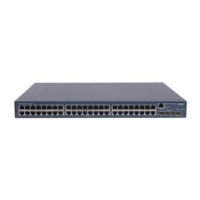1-14
Table 1-6 Port states supported by different port roles
Port role (right)
Port state
(below)
Root port/master
port
Designated port Alternate port Backup port
Forwarding √ √ — —
Learning √ √ — —
Discarding √ √ √ √
How MSTP Works
MSTP divides an entire Layer 2 network into multiple MST regions, which are interconnected by a
calculated CST. Inside an MST region, multiple spanning trees are calculated, each being called an
MSTI. Among these MSTIs, MSTI 0 is the IST, while all the others are MSTIs. Similar to STP, MSTP
uses configuration BPDUs to calculate spanning trees. The only difference between the two protocols is
that an MSTP BPDU carries the MSTP configuration on the device from which this BPDU is sent.
CIST calculation
The calculation of a CIST tree is also the process of configuration BPDU comparison. During this
process, the device with the highest priority is elected as the root bridge of the CIST. MSTP generates
an IST within each MST region through calculation, and, at the same time, MSTP regards each MST
region as a single device and generates a CST among these MST regions through calculation. The CST
and ISTs constitute the CIST of the entire network.
MSTI calculation
Within an MST region, MSTP generates different MSTIs for different VLANs based on the
VLAN-to-instance mappings. MSTP performs a separate calculation process, which is similar to
spanning tree calculation in STP, for each spanning tree. For details, refer to How STP works
.
In MSTP, a VLAN packet is forwarded along the following paths:
z Within an MST region, the packet is forwarded along the corresponding MSTI.
z Between two MST regions, the packet is forwarded along the CST.
Implementation of MSTP on Devices
MSTP is compatible with STP and RSTP. STP and RSTP protocol packets can be recognized by
devices running MSTP and used for spanning tree calculation.
In addition to basic MSTP functions, many special functions are provided for ease of management, as
follows:
z Root bridge hold
z Root bridge backup
z Root guard
z BPDU guard
z Loop guard
z TC-BPDU guard

